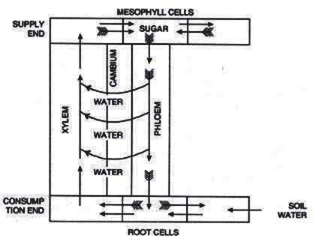 Long Answer Type
Long Answer Type(a) Describe the structure of arteries, veins and capillaries. Explain the way in which each of these is adapted for its function.
(b) Give an account of the ‘Mass Flow Hypothesis’ for translocation of solutes.
(c) Give the meaning of the following:
(i) Digestion (ii) Assimilation
(a)
1. Arteries - Structure of Arteries: Arteries are those blood vessels which carry oxygenated blood from the heart to all the other parts of the body. They have thick and elastic walls. The wall of arteries is made up of three layers which are given below:
(i) Tunica externa or adventitia: It is the outermost layer of the artery and is made up of loosely arranged elastic and collagen fibres.
(ii) Tunica media: It is the middle layer of the artery. It is made up of circular smooth or unstriated muscle fibres and elastic connective fibres. It is well developed and makes the artery non-collapsible.
(iii) Tunica Interna or Intima: It is the innermost layer of the artery. It is made up of flat endothelial cells and is lined internally by an elastic membrane.
Adaptations: The arteries have narrow lumen and very thick walls which enables them to carry blood under high pressure and jerks effectively.
(2) Veins: Veins are the blood vessels which bring deoxygenated blood from various body parts to the heart. They have wider lumen and thinner walls as compared to arteries.
The veins are thin-walled and collapsible. They contain semilunar valves. These valves prevent the backflow of blood as the blood flows very slow and under low pressure in the veins.
Veins are also made up of three layer as the arteries but these layers are very thin in the veins. That is why the walls of veins are thinner as compared to the arteries. The veins are more elastic than the arteries.Adaptations : Presence of valves and wide lumen make them suitable to their work.
(3) Capillaries : Capillaries are the fine blood vessels which are found abundantly in those tissues where extensive metabolism takes place. The walls of capillaries are very thin as they bring the blood in the closest contact with the surrounding tissue. The walls of capillaries are made up of only tunica interna whereas tunica externa and tunica media are absent.
Adaptations : The extremely thin walls of the capillaries help them in performing their functions.According to Munch’s hypothesis, as a result of photosynthesis, the mesophyll cells in the leaves contain a higher concentration of organic food material in them and correspond to supply end. The cells of stem and roots where the food material is utilised or converted into insoluble form correspond to consumption end.
Mesophyll cells draw water from the xylem of the leaf due to higher osmotic pressure and suction pressure of their sap so that their turgor pressure is increased. The turgor pressure in the cells of stem and the roots is comparatively low and hence, the soluble organic solutes begin to flow en mass from mesophyll through phloem down to the cells of stem and the roots under the gradient of turgor pressure. In the cells of stem and the roots the organic solutes are either consumed or converted into insoluble form and the excess water is released into xylem through cambium.
(c)
(i) Digestion : It is the breakdown of food materials into the constituent nutrients with the help of certain enzymes inside the body of an organism.
(ii) Assimilation : It is the incorporation of absorbed food materials in the processes of growth, repair and reproduction by the organism.
(a) Give a schematic representation of non-cyclic photophosphorylation showing both the photosystem.
(b) Describe the structure of a myofibril of a striated muscle.
(c) Give four points to show the importance of vegetative propagation.
(a) Describe the mechanism of inspiration and expiration in man.
(b) Draw a labelled diagram of the vertical section of the human eye.
(c) (i) What is Ageing?
(ii) Give two functions of the amniotic fluid.
(a)
(i) Draw a labelled diagram of chloroplast as seen under an electron microscope.
(ii) Name the three major photosynthetic pigments.
(b) Describe the events that take place between pollination and fertilisation in plant.
(c) Name the hormones associated with the following :
(i) The only gaseous plant regulator.
(ii) A growth inhibitor in plants.
(iii) Resorption of water from the urine in the distil convoluted tubule.
(iv) Rise in blood calcium.
(a) Explain the DDT resistance of mosquitoes to the pesticide.
(b) What are the symptoms of Diabetes mellitus?
(c) Define :
(i) Gene pool
(ii) Genetic Erosion.
(a) Write short notes on:
(i) DNA finger printing
(ii) Cryopreservation
(iii) Hemophilia
(iv) Green manure.
(b) What are the activities of Community Health Services.
(c) Give the differences between B cells and T cells.
(a) Describe Lederberg’s Replica Plating experiment to show the genetic basis of adaptation.
(b) Give an account of chromosomal aberrations (mutations).
(c) What is a pacemaker?